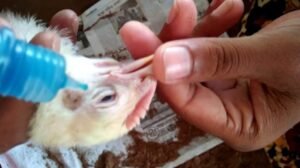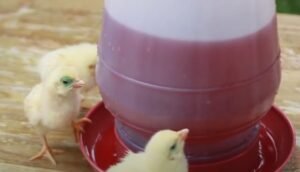Detailed Discussion: Use of Dye Indicators in Poultry Vaccines

Dr. Majed Hamed Al Saegh / poultry pathologist / Australia
- Introduction to the Use of Dye Indicators in Poultry Vaccines
Dye indicators such as Vacci Blue are used to improve the efficiency of vaccination processes and ensure that all birds consume the vaccine. These dyes add a visual aspect to the vaccination process, allowing for immediate and comprehensive assessment.
- Composition of Vacci Blue
Component Chemical Formula Function Typical Concentration
Blue Dye (E133) Brilliant Blue FCF Adds a distinct colour to visually identify vaccinated birds 10 g per 100 L of water
Sodium Thiosulfate Na₂S₂O₃ Acts as a chlorine neutraliser to stabilise the vaccine 1–2 g per 100 L of water
Sodium Bicarbonate NaHCO₃ Provides pH buffering to ensure vaccine stability 0.5–1 g per 100 L of water
Disodium EDTA (Trilon B) Ethylenediaminetetraacetic Acid (EDTA) Binds heavy metal ions to prevent precipitation 0.1–0.5 g per 100 L of water
- Functions of the Components in Detail
Blue Dye (Brilliant Blue FCF – E133):
Role:
Adds a visible blue colour that appears on the beak or tongue of birds after consuming the treated water, making it easy to track the vaccination process.
Properties:
Non-toxic.
Fully water-soluble.
Approved by international organisations for use in food industries.
Sodium Thiosulfate (Na₂S₂O₃):
Role:
Neutralises chlorine in water, which can otherwise reduce vaccine efficacy.
Properties:
Effective chlorine remover.
Ensures solution stability during vaccination.
Sodium Bicarbonate (NaHCO₃):
Role:
Acts as a pH buffer, preventing significant changes in pH that could affect vaccine stability.
Properties:
Maintains a stable environment for the vaccine in water.
Disodium EDTA (Trilon B):
Role:
Chelates heavy metal ions like iron and calcium, preventing them from precipitating and affecting vaccine solubility.
Properties:
Improves the solubility of the vaccine.
Maintains vaccine effectiveness by preventing unwanted chemical reactions.

- Practical Benefits of Dye Indicators in Vaccines
Benefit Practical Impact
Ease of Monitoring Vaccination Provides a clear visual indication of vaccinated birds, simplifying monitoring.
Ensures Uniform Vaccine Distribution Guarantees even mixing and distribution of the vaccine in drinking water.
Improves Vaccination Quality Reduces the risk of missed vaccinations, enhancing overall flock health.
Maintains Vaccine Stability Neutralises harmful water components like chlorine and heavy metals.
Saves Time and Effort Allows quick visual identification of vaccinated birds, reducing labour requirements.
- Safety and Environmental Considerations
Safety of Components:
All components of Vacci Blue, including the dye E133, are approved and safe for use in food and animal products.
The recommended doses pose no harm to birds or humans consuming poultry products (meat or eggs).
Environmental Impact:
Vacci Blue’s components are biodegradable, reducing their environmental footprint.
Adhering to recommended dosages prevents unnecessary accumulation of chemicals in the environment.
Special Considerations:
Store Vacci Blue in a dry and cool place to maintain its effectiveness.
Mix the solution accurately according to guidelines to avoid over-dilution or excessive coloring.
- Challenges in Using Vacci Blue
Challenge Explanation
Additional Costs Adding Vacci Blue to the vaccination program may increase operational costs, particularly for small farms.
Need for Farmer Training Farmers may require additional training to ensure proper dosing and monitoring.
Individual Sensitivity In rare cases, some birds may show sensitivity to specific components, requiring close observation.
- Future Prospects
Development of Multifunctional Dyes:
Future dyes could combine coloring with immune-boosting properties or enhance vaccine absorption.
Environmentally Friendly Dyes:
Developing formulations that are more environmentally friendly to minimize long-term ecological impact.
Wider Applications:
Expanding the use of dye indicators in other vaccines or different farming systems.

- Conclusion
Dye indicators like Vacci Blue are a valuable addition to poultry vaccination programs. Their unique composition and safety make them ideal for ensuring comprehensive coverage and high effectiveness in vaccination processes. With further development, these indicators could become standard tools in modern poultry farming.



